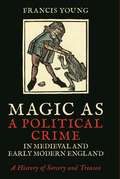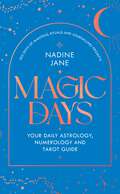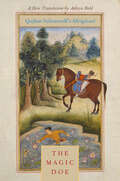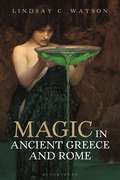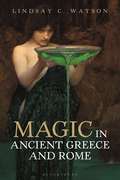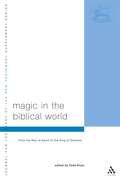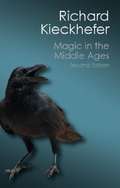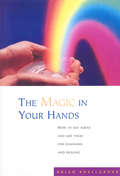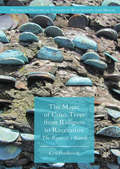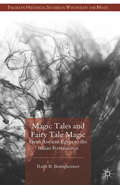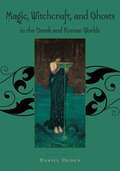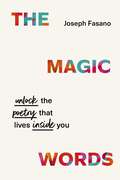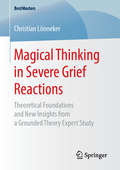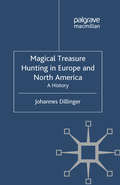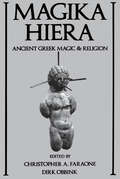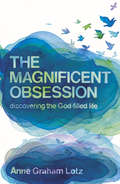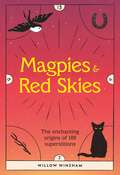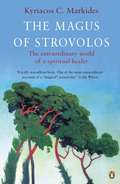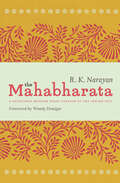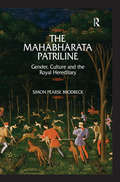- Table View
- List View
Magic as a Political Crime in Medieval and Early Modern England: A History of Sorcery and Treason (International Library of Historical Studies)
by Francis YoungTreason and magic were first linked together during the reign of Edward II. Theories of occult conspiracy then regularly led to major political scandals, such as the trial of Eleanor Cobham Duchess of Gloucester in 1441. While accusations of magical treason against high-ranking figures were indeed a staple of late medieval English power politics, they acquired new significance at the Reformation when the 'superstition' embodied by magic came to be associated with proscribed Catholic belief. Francis Young here offers the first concerted historical analysis of allegations of the use of magic either to harm or kill the monarch, or else manipulate the course of political events in England, between the fourteenth century and the dawn of the Enlightenment. His book addresses a subject usually either passed over or elided with witchcraft: a quite different historical phenomenon. He argues that while charges of treasonable magic certainly were used to destroy reputations or to ensure the convictions of undesirables, magic was also perceived as a genuine threat by English governments into the Civil War era and beyond.
Magic Days: Unlock your daily magic with the power of astrology, rituals and journalling for spiritual self-care
by Nadine JaneRead one page a day to transform your life.What if self-care, self-empowerment and self-understanding started with a single page? Astrology, numerology, and tarot are rituals with ancient roots that are observed around the world for their ability to help us reconnect with your inner self and feel the magic around - and within - ourselves. With many practices to draw from, astrology guru Nadine Jane has combined the essence of the most popular forms of divination in one single volume.Magic Days is your go-to 'spiritual almanac'. It guides each star sign through the astrological year and offers insight into how the stars are shaping your destiny. Each page is laid out with everything you need to know and includes mantras, rituals and journal prompts to help you reflect on the day's wisdom and channel the energy you need to thrive.The book charts your year and offers guidance on what your relationships and spiritual journey have in store. Whether you're dipping your toes into spiritual waters for the first time, are a devoted reader of your daily horoscope or just secretly wants to know what the future may have in store for you, Magic Days is the perfect guide to year-round spiritual wellbeing.
The Magic Doe: Qutban Suhravardi's Mirigavati
by Aditya Behl Wendy DonigerMirigavati or The Magic Doe is the work of Shaikh Qutban Suhravardi, an Indian Sufi master who was also an expert poet and storyteller attached to the glittering court-in-exile of Sultan Husain Shah Sharqi of Jaunpur. Composed in 1503 as an introduction to mystical practice for disciples, this powerful Hindavi or early Hindi Sufi romance is a richly layered and sophisticated text, simultaneously a spiritual enigma and an exciting love story full of adventures. The Mirigavati is both an excellent introduction to Sufism and one of the true literary classics of pre-modern India, a story that draws freely on the large pool of Indian, Islamic, and European narrative motifs in its distinctive telling of a mystical quest and its resolution. Adventures from the Odyssey and the voyages of Sindbad the Sailor--sea voyages, encounters with monstrous serpents, damsels in distress, flying demons and cannibals in caves, among others--surface in Suhravardi 's rollicking tale, marking it as first-rate entertainment for its time and, in private sessions in Sufi shrines, a narrative that shaped the interior journey for novices. Before his untimely death in 2009, Aditya Behl had finished this complete blank verse translation of the critical edition of the Mirigavati, an epic romance that is also the symbolic key to a secret Sufi mystical tradition and a gem of Indian and world literature.
Magic in Ancient Greece and Rome
by Lindsay C. WatsonParting company with the trend in recent scholarship to treat the subject in abstract, highly theoretical terms, Magic in Ancient Greece and Rome proposes that the magic-working of antiquity was in reality a highly pragmatic business, with very clearly formulated aims - often of an exceedingly maligant kind. In seven chapters, each addressed to an important arm of Greco-Roman magic, the volume discusses the history of the rediscovery and publication of the so-called Greek Magical Papyri, a key source for our understanding of ancient magic; the startling violence of ancient erotic spells and the use of these by women as well as men; the alteration in the landscape of defixio (curse tablet) studies by major new finds and the confirmation these provide that the frequently lethal intent of such tablets must not be downplayed; the use of herbs in magic, considered from numerous perspectives but with an especial focus on the bizarre-seeming rituals and protocols attendant upon their collection; the employment of animals in magic, the factors determining the choice of animal, the uses to which they were put, and the procuring and storage of animal parts, conceivably in a sorcerer's workshop; the witch as a literary construct, the clear homologies between the magical procedures of fictional witches and those documented for real spells, the gendering of the witch-figure and the reductive presentation of sorceresses as old, risible and ineffectual; the issue of whether ancient magicians practised human sacrifice and the illuminating parallels between such accusations and late 20th century accounts of child-murder in the context of perverted Satanic rituals.By challenging a number of orthodoxies and opening up some underexamined aspects of the subject, this wide-ranging study stakes out important new territory in the field of magical studies.
Magic in Ancient Greece and Rome
by Lindsay C. WatsonParting company with the trend in recent scholarship to treat the subject in abstract, highly theoretical terms, Magic in Ancient Greece and Rome proposes that the magic-working of antiquity was in reality a highly pragmatic business, with very clearly formulated aims - often of an exceedingly maligant kind. In seven chapters, each addressed to an important arm of Greco-Roman magic, the volume discusses the history of the rediscovery and publication of the so-called Greek Magical Papyri, a key source for our understanding of ancient magic; the startling violence of ancient erotic spells and the use of these by women as well as men; the alteration in the landscape of defixio (curse tablet) studies by major new finds and the confirmation these provide that the frequently lethal intent of such tablets must not be downplayed; the use of herbs in magic, considered from numerous perspectives but with an especial focus on the bizarre-seeming rituals and protocols attendant upon their collection; the employment of animals in magic, the factors determining the choice of animal, the uses to which they were put, and the procuring and storage of animal parts, conceivably in a sorcerer's workshop; the witch as a literary construct, the clear homologies between the magical procedures of fictional witches and those documented for real spells, the gendering of the witch-figure and the reductive presentation of sorceresses as old, risible and ineffectual; the issue of whether ancient magicians practised human sacrifice and the illuminating parallels between such accusations and late 20th century accounts of child-murder in the context of perverted Satanic rituals.By challenging a number of orthodoxies and opening up some underexamined aspects of the subject, this wide-ranging study stakes out important new territory in the field of magical studies.
Magic in the Biblical World: From the Rod of Aaron to the Ring of Solomon (The Library of New Testament Studies #245)
by Todd KlutzThe category 'magic' , long used to signify an allegedly substantive type of activity distinguishable from 'religion', has nearly been dismantled by recent historical and social-scientific approaches to religious studies. While recognising and at times reinforcing this stance, the essays in this collection show that there is still much to be learned about the cultural context of early Judaism and Christianity by analysing ancient texts which either use 'magic' as a category for purposes of deviance labelling or promote behaviour of a broadly magico-religious variety. Through sustained engagement with texts ranging from Exod. 7-9 and Acts 8 to the Testament of Solomon and the Late Antique alchemical treatise known as the Cyranides, this volume focuses chiefly on materials that challenge the familiar boundaries between miracle and magic and medicine; yet it also heightens awareness of the way unsuspecting use of a sick sign (e.g. 'magic') can impede critical understanding of texts and their respective contexts of production and reception.Journal for the Study of the New Testament Supplement Series, Volume 245.
Magic in the Middle Ages (PDF)
by Richard KieckheferHow was magic practised in medieval times? How did it relate to the diverse beliefs and practices that characterised this fascinating period? In Magic in the Middle Ages Richard Kieckhefer surveys the growth and development of magic in medieval times. He examines its relation to religion, science, philosophy, art, literature and politics before introducing us to the different types of magic that were used, the kinds of people who practised magic and the reasoning behind their beliefs. In addition, he shows how magic served as a point of contact between the popular and elite classes, how the reality of magical beliefs is reflected in the fiction of medieval literature and how the persecution of magic and witchcraft led to changes in the law. This book places magic at the crossroads of medieval culture, shedding light on many other aspects of life in the Middle Ages.
The Magic In Your Hands: How to See Auras and Use Them for Diagnosis and Healing
by Brian SnellgroveIn this book Brian Snellgrove will provide you with a method for seeing and tuning into other peoples' auras - their problems, their needs and understanding them, without a requirement for words.The author, who had an international practice in South Africa, Australia, Finland, Ireland and the UK, shares his experience of benign and non-invasive method of analysis.Of use to counsellors, therapists, healers, sensitives - in fact anyone having to do with human nature in all its aspects - this technique is a well-tested and accurate way of determining how clients can be most effectively helped to understand and face their circumstances.
The Magic of Coin-Trees from Religion to Recreation: The Roots of a Ritual (Palgrave Historical Studies in Witchcraft and Magic)
by Ceri HoulbrookThis book traces the history of ritual landscapes in the British Isles, and the transition from religious practice to recreation, by focusing on a highly understudied exemplar: the coin-tree. These are trees imbued with magical properties into which coins have been ritually embedded. This is a contemporary custom which can be traced back in the literature to the 1700s, when it was practiced for folk-medical and dedicatory purposes. Today, the custom is widespread, with over 200 coin-trees distributed across the British Isles, but is more akin to the casual deposition of coins in a wishing-well: coins are deposited in the tree in exchange for wishes, good luck, or future fortune. Ceri Houlbrook contributes to the debate on the historic relationships between religion, ritual, and popular magic in British contexts from 1700 to the present.
The Magic of Coin-Trees from Religion to Recreation: The Roots of a Ritual (Palgrave Historical Studies in Witchcraft and Magic)
by Ceri HoulbrookThis book traces the history of ritual landscapes in the British Isles, and the transition from religious practice to recreation, by focusing on a highly understudied exemplar: the coin-tree. These are trees imbued with magical properties into which coins have been ritually embedded. This is a contemporary custom which can be traced back in the literature to the 1700s, when it was practiced for folk-medical and dedicatory purposes. Today, the custom is widespread, with over 200 coin-trees distributed across the British Isles, but is more akin to the casual deposition of coins in a wishing-well: coins are deposited in the tree in exchange for wishes, good luck, or future fortune. Ceri Houlbrook contributes to the debate on the historic relationships between religion, ritual, and popular magic in British contexts from 1700 to the present.
Magic Tales and Fairy Tale Magic: From Ancient Egypt to the Italian Renaissance (Palgrave Historical Studies in Witchcraft and Magic)
by R. BottigheimerThis book examines magic's generally maleficent effect on humans from ancient Egypt through the Middle Ages, including tales from classical mythology, Jewish, Christian, and Muslim cultures. It shows that certain magical motifs lived on from age to age, but that it took until the Italian Renaissance for magic tales to become fairy tales.
Magic, Witchcraft And Ghosts In The Greek And Roman Worlds: A Sourcebook
by Daniel OgdenIn a culture where the supernatural possessed an immediacy now strange to us, magic was of great importance both in the literary and mythic tradition and in ritual practice. Recently, ancient magic has hit a high in popularity, both as an area of scholarly inquiry and as one of general, popular interest. In Magic, Witchcraft, and Ghosts in the Greek and Roman Worlds Daniel Ogden presents three hundred texts in new translations, along with brief but explicit commentaries. This is the first book in the field to unite extensive selections from both literary and documentary sources. Alongside descriptions of sorcerers, witches, and ghosts in the works of ancient writers, it reproduces curse tablets, spells from ancient magical recipe books, and inscriptions from magical amulets. Each translation is followed by a commentary that puts it in context within ancient culture and connects the passage to related passages in this volume. Authors include the well known (Sophocles, Herodotus, Plato, Aristotle, Virgil, Pliny) and the less familiar, and extend across the whole of Greco-Roman antiquity. The second edition includes a new preface, an updated bibliography, and new source-passages, such as the earliest use of the word "mage" in Greek" (fr. Aeschylus' Persians ), a werewolf tale (Aesop's Fables), and excerpts from the most systematic account of ancient legislation against magic (Theodosian Code).
The Magic Words
by Joseph FasanoDiscover the joy of expressing what’s inside you, with fill-in-the-blank poems that are sparking a creative movement.We all have stories inside us, whether or not we consider ourselves ‘creative’. And with these 50 simple fill-in-the-blank poems, anyone can write poetry, whatever age or ability. By adding just a few words of your own, you create something beautiful and wholly new that comes from within.Discover the magic of putting your feelings into words and be inspired by sample poems submitted by people of all ages and walks of life. Exploring themes like friendship, love, grief, gratitude, and hope, these inclusive, accessible, and deceptively simple poems express powerful emotional truths, written by you.Discover the joy of expressing what’s inside you, with fill-in-the-blank poems that are sparking a creative movement
Magical Thinking in Severe Grief Reactions: Theoretical Foundations and New Insights from a Grounded Theory Expert Study (BestMasters)
by Christian LönnekerChristian Lönneker systematically explores the phenomenon of magical thinking in the context of severe grief reactions focusing on intrusive forms reported by bereaved individuals seeking professional support. The author succeeds in proposing a comprehensive definition of magical thinking and a rationale for its association with grief based on various disciplines, such as psychology, anthropology, and the cognitive science of religion. Within the scope of a grounded theory study, case reports comprise themes like bringing the deceased back to life, the magical efficacy of religious rituals, and attempts to ward off harmful influences of the dead.
Magical Treasure Hunting in Europe and North America: A History (Palgrave Historical Studies in Witchcraft and Magic)
by J. DillingerThe first comprehensive history of magical treasure hunting from the Middle Ages to the 20th century, revealing a magical universe of treasure spirits, and wizards who tried to deal with them. Combining history and anthropology, this study sees treasure hunting as an expression of shifting economic mentalities and changing ideas about history.
Magika Hiera: Ancient Greek Magic and Religion
by Christopher A. Faraone Dirk ObbinkThis collection challenges the tendency among scholars of ancient Greece to see magical and religious ritual as mutually exclusive and to ignore "magical" practices in Greek religion. The contributors survey specific bodies of archaeological, epigraphical, and papyrological evidence for magical practices in the Greek world, and, in each case, determine whether the traditional dichotomy between magic and religion helps in any way to conceptualize the objective features of the evidence examined. Contributors include Christopher A. Faraone, J.H.M. Strubbe, H.S. Versnel, Roy Kotansky, John Scarborough, Samuel Eitrem, Fritz Graf, John J. Winkler, Hans Dieter Betz, and C.R. Phillips.
The Magnificent Obsession: Discovering the God-filled Life
by Anne Graham LotzWhen Anne Graham Lotz studied the life of Abraham in depth it changed her view of her own life forever. This book is the result of that life-transforming study, which drew her into a deeper friendship with God and set her on a journey of being a blessing to others.Combining a reflective study of the biblical account of Abraham, the founder of the Jewish and Christian faiths, with challenging meditations on the reality of being a disciple, this book is an invitation to all who long to live the God-filled life.
Magpies & Red Skies: The enchanting origins of 100 superstitions
by Willow WinshamFind a penny, pick it up All day long you'll have good luckWhether hopping over cracks, saluting magpies or knocking on wood, we all seek good fortune through performing curious rituals. But is there ancient wisdom behind the folklore of superstition?In this exquisitely illustrated tour through thousands of years of tradition, Willow Winsham explores the mysterious origins behind 100 of the most intriguing superstitions from across the globe.
The Magus of Strovolos: The Extraordinary World of a Spiritual Healer (Compass Ser.)
by Kyriacos MarkidesIn this vivid account, Kryiacos C Markides introduces to us the rich and intricate world of Daskalso, The Magus of Strovolos. In what appears at first to be an exercise in fantasy, we see Daskalos draw on seemingly unlimited mixture of esoteric teachings, psychology, reincarnation, demonology, cosmology and mysticism, from both eastern and western traditions. But Daskalos is first and foremost a healer, whose work is firmly rooted in a belied in 'Holyspirit' or absolute love, and whose aim is the expansion of reason and spiritual evolution.
The Mahabharata: A Shortened Modern Prose Version of the Indian Epic
by R. K. NarayanThe Mahabharata tells a story of such violence and tragedy that many people in India refuse to keep the full text in their homes, fearing that if they do, they will invite a disastrous fate upon their house. Covering everything from creation to destruction, this ancient poem remains an indelible part of Hindu culture and a landmark in ancient literature. Centuries of listeners and readers have been drawn to The Mahabharata, which began as disparate oral ballads and grew into a sprawling epic. The modern version is famously long, and at more than 1.8 million words—seven times the combined lengths of the Iliad and Odyssey—it can be incredibly daunting. Contemporary readers have a much more accessible entry point to this important work, thanks to R. K. Narayan’s masterful translation and abridgement of the poem. Now with a new foreword by Wendy Doniger, as well as a concise character and place guide and a family tree, The Mahabharata is ready for a new generation of readers. As Wendy Doniger explains in the foreword, “Narayan tells the stories so well because they’re all his stories.” He grew up hearing them, internalizing their mythology, which gave him an innate ability to choose the right passages and their best translations. In this elegant translation, Narayan ably distills a tale that is both traditional and constantly changing. He draws from both scholarly analysis and creative interpretation and vividly fuses the spiritual with the secular. Through this balance he has produced a translation that is not only clear, but graceful, one that stands as its own story as much as an adaptation of a larger work.
The Mahabharata: A Shortened Modern Prose Version of the Indian Epic
by R. K. NarayanThe Mahabharata tells a story of such violence and tragedy that many people in India refuse to keep the full text in their homes, fearing that if they do, they will invite a disastrous fate upon their house. Covering everything from creation to destruction, this ancient poem remains an indelible part of Hindu culture and a landmark in ancient literature. Centuries of listeners and readers have been drawn to The Mahabharata, which began as disparate oral ballads and grew into a sprawling epic. The modern version is famously long, and at more than 1.8 million words—seven times the combined lengths of the Iliad and Odyssey—it can be incredibly daunting. Contemporary readers have a much more accessible entry point to this important work, thanks to R. K. Narayan’s masterful translation and abridgement of the poem. Now with a new foreword by Wendy Doniger, as well as a concise character and place guide and a family tree, The Mahabharata is ready for a new generation of readers. As Wendy Doniger explains in the foreword, “Narayan tells the stories so well because they’re all his stories.” He grew up hearing them, internalizing their mythology, which gave him an innate ability to choose the right passages and their best translations. In this elegant translation, Narayan ably distills a tale that is both traditional and constantly changing. He draws from both scholarly analysis and creative interpretation and vividly fuses the spiritual with the secular. Through this balance he has produced a translation that is not only clear, but graceful, one that stands as its own story as much as an adaptation of a larger work.
The Mahabharata: A Shortened Modern Prose Version of the Indian Epic
by R. K. NarayanThe Mahabharata tells a story of such violence and tragedy that many people in India refuse to keep the full text in their homes, fearing that if they do, they will invite a disastrous fate upon their house. Covering everything from creation to destruction, this ancient poem remains an indelible part of Hindu culture and a landmark in ancient literature. Centuries of listeners and readers have been drawn to The Mahabharata, which began as disparate oral ballads and grew into a sprawling epic. The modern version is famously long, and at more than 1.8 million words—seven times the combined lengths of the Iliad and Odyssey—it can be incredibly daunting. Contemporary readers have a much more accessible entry point to this important work, thanks to R. K. Narayan’s masterful translation and abridgement of the poem. Now with a new foreword by Wendy Doniger, as well as a concise character and place guide and a family tree, The Mahabharata is ready for a new generation of readers. As Wendy Doniger explains in the foreword, “Narayan tells the stories so well because they’re all his stories.” He grew up hearing them, internalizing their mythology, which gave him an innate ability to choose the right passages and their best translations. In this elegant translation, Narayan ably distills a tale that is both traditional and constantly changing. He draws from both scholarly analysis and creative interpretation and vividly fuses the spiritual with the secular. Through this balance he has produced a translation that is not only clear, but graceful, one that stands as its own story as much as an adaptation of a larger work.
The Mahabharata: A Shortened Modern Prose Version of the Indian Epic
by R. K. NarayanThe Mahabharata tells a story of such violence and tragedy that many people in India refuse to keep the full text in their homes, fearing that if they do, they will invite a disastrous fate upon their house. Covering everything from creation to destruction, this ancient poem remains an indelible part of Hindu culture and a landmark in ancient literature. Centuries of listeners and readers have been drawn to The Mahabharata, which began as disparate oral ballads and grew into a sprawling epic. The modern version is famously long, and at more than 1.8 million words—seven times the combined lengths of the Iliad and Odyssey—it can be incredibly daunting. Contemporary readers have a much more accessible entry point to this important work, thanks to R. K. Narayan’s masterful translation and abridgement of the poem. Now with a new foreword by Wendy Doniger, as well as a concise character and place guide and a family tree, The Mahabharata is ready for a new generation of readers. As Wendy Doniger explains in the foreword, “Narayan tells the stories so well because they’re all his stories.” He grew up hearing them, internalizing their mythology, which gave him an innate ability to choose the right passages and their best translations. In this elegant translation, Narayan ably distills a tale that is both traditional and constantly changing. He draws from both scholarly analysis and creative interpretation and vividly fuses the spiritual with the secular. Through this balance he has produced a translation that is not only clear, but graceful, one that stands as its own story as much as an adaptation of a larger work.
The Mahabharata Patriline: Gender, Culture, and the Royal Hereditary
by Simon Pearse BrodbeckThe Sanskrit Mahabharata (which contains the Bhagavad Gita) is sorely neglected as a classic - perhaps the classic - of world literature, and is of particularly timely human importance in today's globalised and war-torn world. This book is a chronological survey of the Sanskrit Mahabharata's central royal patriline - a family tree that is also a list of kings. Brodbeck explores the importance and implications of patrilineal maintenance within the royal culture depicted by the text, and shows how patrilineal memory comes up against the fact that in every generation a wife must be involved, with the consequent danger that the children might not sustain the memorial tradition of their paternal family. The Mahabharata Patriline bridges a gap in text-critical methodology between the traditional philological approach and more recent trends in gender and literary theory. Studying the Mahabharata as an integral literary unit and as a story stretched over dozens of generations, this book casts particular light on the events of the more recent generations and suggests that the text's internal narrators are members of the family whose story they tell.
The Mahabharata Patriline: Gender, Culture, and the Royal Hereditary
by Simon Pearse BrodbeckThe Sanskrit Mahabharata (which contains the Bhagavad Gita) is sorely neglected as a classic - perhaps the classic - of world literature, and is of particularly timely human importance in today's globalised and war-torn world. This book is a chronological survey of the Sanskrit Mahabharata's central royal patriline - a family tree that is also a list of kings. Brodbeck explores the importance and implications of patrilineal maintenance within the royal culture depicted by the text, and shows how patrilineal memory comes up against the fact that in every generation a wife must be involved, with the consequent danger that the children might not sustain the memorial tradition of their paternal family. The Mahabharata Patriline bridges a gap in text-critical methodology between the traditional philological approach and more recent trends in gender and literary theory. Studying the Mahabharata as an integral literary unit and as a story stretched over dozens of generations, this book casts particular light on the events of the more recent generations and suggests that the text's internal narrators are members of the family whose story they tell.
